Description of the satanic mushroom, how to distinguish it from edible ones. Double edible porcini mushrooms: a description of the satanic mushroom
satanic mushroom(Boletus satanas) belongs to the Boletov family, the Boletus genus, it can also be called a devil's mushroom, poisonous (some sources indicate that it is conditionally edible).
- Differs in large sizes. The hat has a hemispherical shape, dry and velvety to the touch, 10 to 25 cm in diameter. The color of the hat is whitish, dirty grayish, with olive or yellow tint. May have stains of pale green, yellow-pink.
- On the inside, the cap is spongy. At young mushroom tubules yellowish, later greenish-yellow. The pores are small, at first yellowish, with age they become orange, red, red-brown, when pressed they turn blue-green.
- The flesh is pleasant in appearance, white or creamy, and reddish in the leg area. On the cut, it slowly changes color, first turns red, then turns blue within a few minutes.
- The structure of the stem is characteristic of the classic boletus: massive, barrel-shaped, tapering towards the cap. Its height can reach from 6 to 15 cm, and its thickness is from 3 to 10 cm. The color in the upper part of the leg, closer to the cap, and at the base, is yellowish, in the middle part it is red or orange-red with a mesh pattern.
The debate about whether the satanic mushroom is edible or not continues to this day. Even raw small piece causes serious harm to the body. But at the same time, the toxin contained in the pulp decomposes under the influence of temperature. On this basis, some experts classify the imp as conditionally edible. True, to neutralize the toxin, you must first soak and then cook the "harvest" for 10 hours. And to say for sure what percentage of toxicity remained after processing is possible only after laboratory analysis (therefore, it is better not to risk it).
Places of distribution
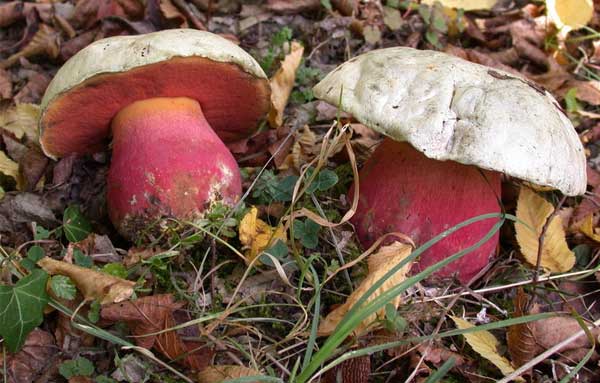
The devil's mushroom is quite rare in our forests - it prefers a warmer climate. Feels more comfortable on calcareous soils. The period of active fruiting is summer and early autumn, singly or in groups.
It lives in deciduous forests, likes to settle next to oaks, chestnuts, lindens. Can be found in beech or hornbeam forests (south of Europe, Russia, Middle East).
How to distinguish from similar species?
Exists whole line boletovs, having a similar appearance. Among them: whitish boletus, pink-skinned boletus (poisonous when raw), false satanic mushroom and others. All of them are inedible.
Among the edible and conditionally edible there are also many twins: white mushroom (true boletus), oak. Porcini differs from the devil in that its flesh does not turn blue on the cut, in young specimens the color of the tubular layer is white or cream, in old specimens it is greenish.
It's more difficult with . The latter has a slightly darker hat, a more pronounced olive tint, but outwardly it is not always possible to distinguish it from a satanic mushroom. Therefore, you have to look at the behavior of the cut of the pulp. In the olive-brown oak tree, it immediately turns blue, and in the poisonous double, it slowly changes color, first to red, and then turns blue.
Signs of poisoning and first aid
The primary signs of poisoning are classic:
- nausea;
- weakness;
- dizziness;
- confusion;
- cutting pain in the abdomen;
- diarrhea.
Then activity is disrupted of cardio-vascular system: pulse quickens, blood pressure decreases. Symptoms of dehydration appear. If help for poisoning with a satanic mushroom is not provided immediately, dehydration is aggravated, the functioning of the liver and kidneys is disrupted. Possible respiratory arrest, paralysis nervous system.
A set of measures to provide assistance includes gastric lavage, intake of adsorbents: soda solution inside or activated carbon. After that, you need to immediately go to the hospital.
Many biologists define the satanic mushroom as conditionally edible, but they do not dare to try it. This representative of the mushroom kingdom is quite insidious: even after correct processing it is difficult to determine whether all toxins have been neutralized. Therefore, you should not risk your health: if you come across a mushroom similar to this one, throw it away.
The satanic mushroom is a poisonous representative of the Borovik genus, the Boletaceae family. Often this dangerous mushroom confused with white, and such consequences can be very serious, it is not for nothing that this mushroom is called the “forest devil” by the people.
The Latin name for the mushroom is Boletus satanas.
External features of the satanic mushroom
These mushrooms are appearance very similar to pink mushrooms. But in the tubular elements of these poisonous mushrooms muscarinic-type toxins are deposited. By structure, these mushrooms belong to the group of mushrooms. Over time, they grow to large sizes. The diameter of the caps in some specimens can reach up to 40 centimeters. Cushion-shaped hat with a smooth surface and dense skin.
On the inside of the cap is a spongy substance dense to the touch. The color of the upper part of the cap is brown, green or olive. The cap and stem feel velvety to the touch. If satanic mushrooms grow in dark forests, then their caps become more prostrate, and the color becomes yellow with an olive tint.
The leg of the satanic mushroom is also outwardly similar to those of the representatives of the mushroom family. The base of the mushroom is massive, and at the junction with the cap it becomes more refined. The usual height of the mushroom is 20 centimeters, with a diameter of up to 12 centimeters.
Places of growth of satanic mushrooms
These mushrooms grow in coniferous, mixed and deciduous forests. They are mainly found in the southern regions. They prefer soil rich in lime.
The fruiting period of satanic mushrooms lasts from July to September. They grow up in small families. They form mycorrhiza with linden, chestnut, hornbeam, beech and hazel. They are found in the Caucasus, the Middle East in the southern part of our country, Primorsky Krai, as well as in southern Europe.
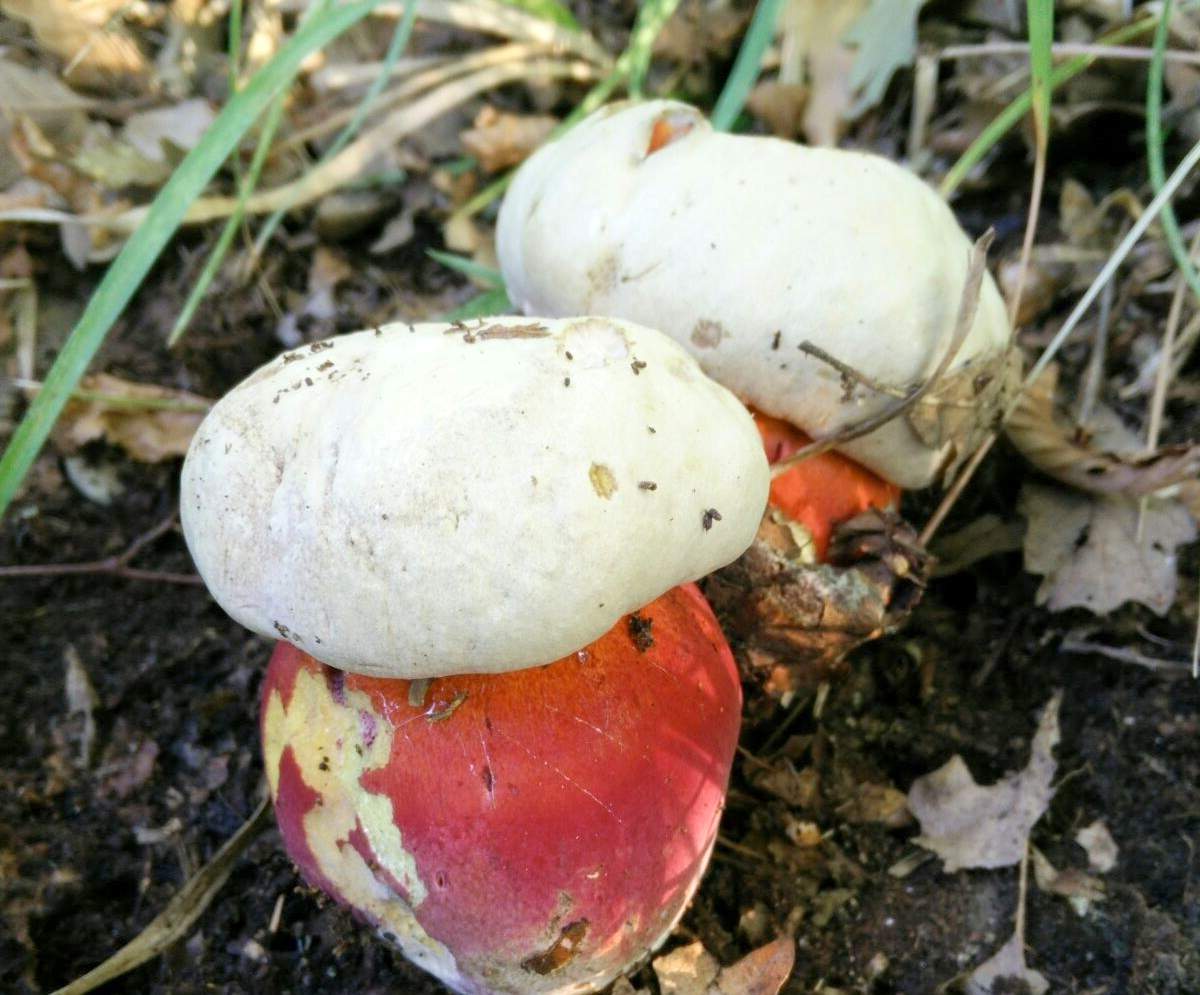
How to recognize a satanic mushroom?
If the leg of a satanic mushroom is cut, then a blue color will appear first, and then bright red. By this sign, you can recognize this poisonous mushroom. In addition, the pulp of the satanic mushroom has the smell of rotten onions. In young specimens, the smell, in general, may be absent.
If you cut the leg, and it turns blue within 3-5 minutes, then this mushroom should be thrown away immediately, because edible mushrooms the color of the pulp on the cut does not change.
Can you eat satanic mushrooms?
In the specialized literature, these mushrooms are classified as conditionally edible. However, it is impossible to use satanic mushrooms for food without prolonged soaking and boiling for less than 10 hours. If these conditions are neglected, then the mushroom picker is threatened with poisoning. Despite the fact that biologists classify satanic mushrooms as conditionally edible, experts do not recommend risking health and collecting them, since the amount of poison at home cannot be determined.
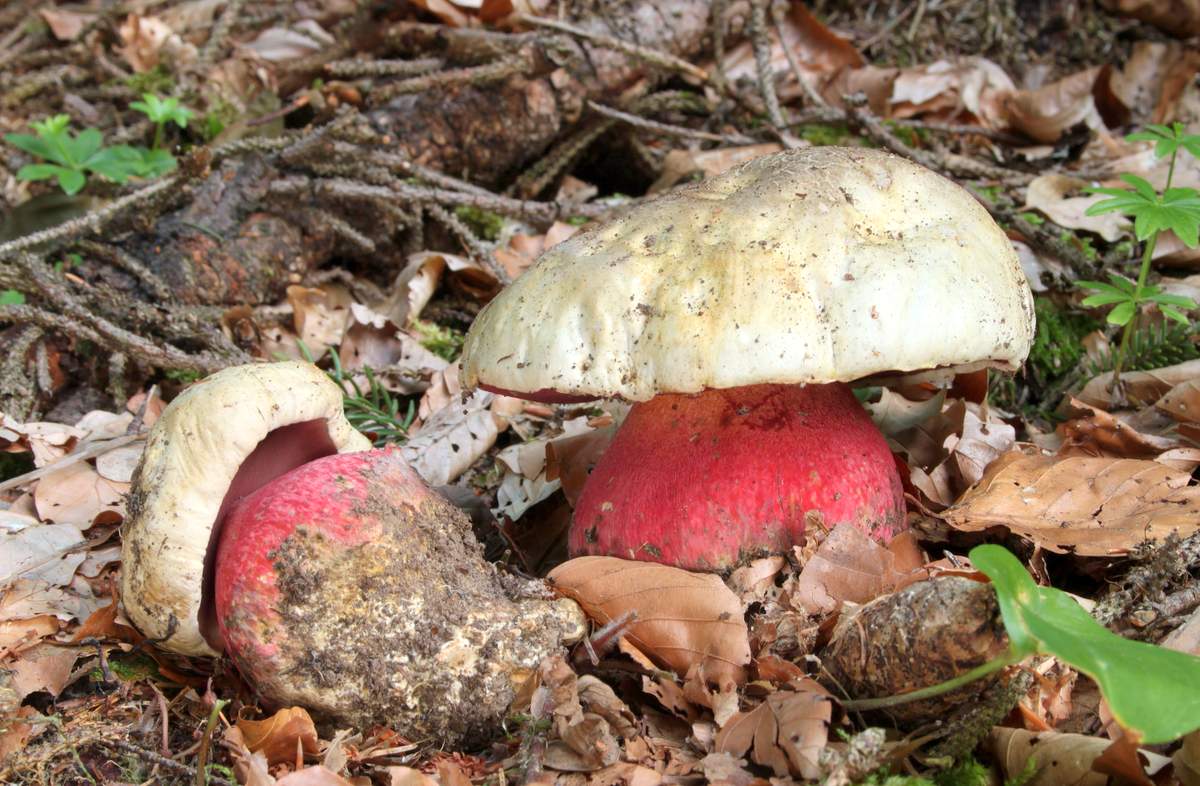
Toxicity and signs of satanic fungus poisoning
The pulp of these mushrooms is poisonous, and if they are not subjected to heat treatment, then the body is poisoned. About 50 grams of mushrooms are enough for poisoning. AT this case toxic damage to the nervous system, liver and spleen occurs. This condition is very serious.
When poisoned with satanic mushrooms, a person opens vomiting and diarrhea, and vomiting is very strong and constant. Paralysis of the limbs, loss of consciousness and severe headaches may occur. Human death can occur due to suffocation and cardiac arrest.
In case of poisoning with satanic mushrooms, the following assistance should be provided:
Rinse the stomach;
Call an ambulance.
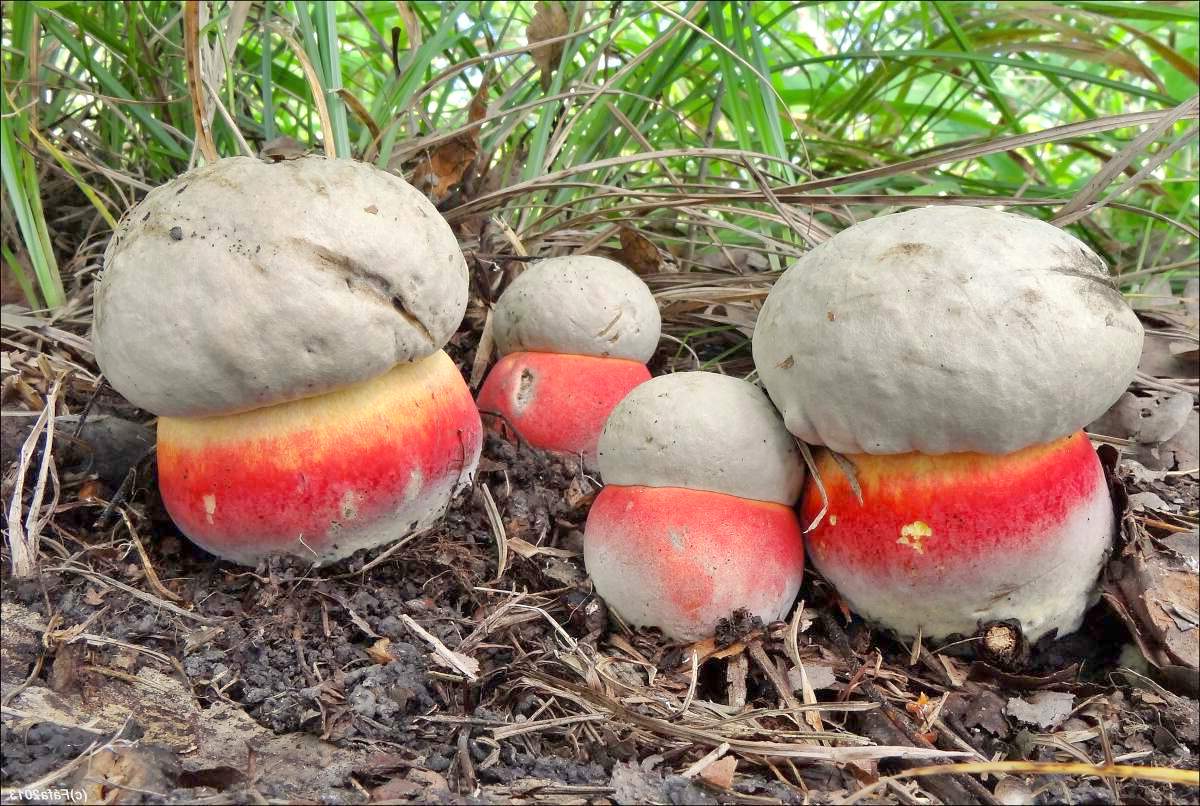
Similar species
Satanic mushrooms are similar to other boletes with bluish flesh and colored spores. Among the inedible representatives, the satanic mushroom can be confused with following mushrooms:
Boletus whitish is not eaten because of its bitter taste;
Boletus rose gold;
Boletus inedible also has a bitter taste, therefore it is inedible;
Borovik le Gal or legal boletus;
False satanic mushroom.
Also, the satanic mushroom can be confused with conditionally edible mushrooms:
Dubovik olive-brown has a hat of brown shades, and its flesh quickly turns blue;
Dubovik speckled has a darker hat, it does not have a mesh on the leg, the flesh also quickly turns blue.
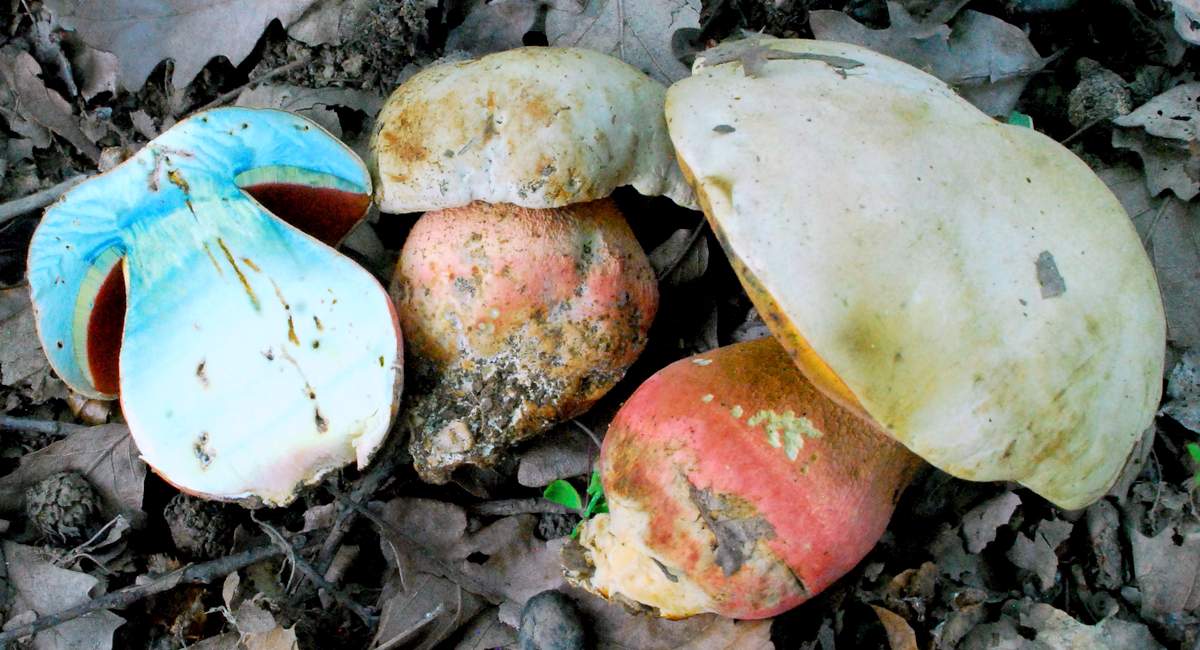
Satanic mushroom (satanic pain) belongs to the genus of mushrooms. It really is very similar to rose gold boletus. But unlike the latter, it is a poisonous mushroom. Most often grows on calcareous soil, in close proximity to oak, hornbeam, hazel, linden in the southern parts of Europe, Asia, the Middle East.
The satanic tinder fungus reaches a large size at the end of summer, the hat of which by that time can reach 30 cm. It is round, cushion-shaped in shape. Mature representatives have a more prostrate form. The skin on the cap is velvety, sometimes smooth to the touch, dry. The color varies from white to off-gray and olive. There are specimens with a yellowish, greenish tint. The leg of the satanic mushroom is massive, reaches 15 cm in height and up to 10 cm in thickness. Young mushrooms stand on a spherical stalk, changing as they grow to barrel-shaped or turnip-shaped. In mature mushrooms, the leg is dense, having a carmine-red mesh pattern in the middle. At the top, it is somewhat narrowed, of a yellowish-red hue. The flesh on the cut turns a little blue, sometimes reddens. Old, overripe mushrooms have bad smell rotting onions or carrion. Young mushrooms do not have a pronounced smell.
In its raw form, the satanic mushroom described above is very poisonous. However, in some European countries they treat it as conditionally edible. It has been proven that the high toxicity of the fungus persists even after prolonged cooking. Therefore, even experienced mushroom picker it should be remembered that the satanic mushroom is a poisonous mushroom!
The satanic mushroom is similar to a beautiful boletus, distinguished by yellow tubules. Some similarities are observed with the bitter bolet, with the exception of a lighter cap and yellow tubules. The purple boletus is similar to satanic, but in the context it has a dark blue color. Similarities are observed with other representatives of the boletus: false satanic mushroom, yellow boletus, devilish mushroom, olive-brown oak, speckled oak.
Mushroom photo
Satanic mushroom (photo) loves open sunny places. Ripening occurs in June and continues until September. The fungus is rare and not well understood. However, it is reliably known that even 1 gr. the fungus causes severe poisoning.
Introduction
Special literature claims that the satanic mushroom is poisonous. However this condition is very relative. The thing is that it becomes edible only after prolonged soaking and cooking for 10 hours. These culinary procedures make it completely inedible. organoleptic properties mushroom pulp. Therefore, many mushroom pickers neglect them in cooking, which can lead to severe damage to the spleen, liver, and nervous system, since the flesh of the satanic mushroom is really poisonous. Read on in the article interesting information associated with this miracle of nature.
Satanic mushroom. Description
As we can see in the photo, its appearance is not much different from the appearance of the most common pink mushrooms. And yet, the striking resemblance that distinguishes the satanic mushroom is very deceptive. For example, the boletus does not carry toxic substances dangerous to human health, while the tubular formations of the satanic fungus actively accumulate and produce muscarinic-type poisons from the earliest period of the development process. In order to notice characteristic symptoms poisoning resulting from the use of this mushroom, it is enough to eat only 50 grams of the ill-fated representative of the forest thicket. 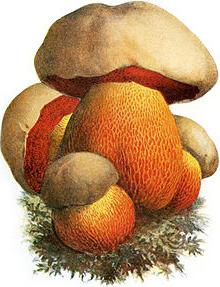 According to its biological structure, the satanic mushroom belongs to the group of mushrooms. He can be found in southern regions on the territory of our country. It usually grows in oak groves or in thickets of a hollow. Much less often, you will find a satanic mushroom next to lindens or hornbeams. In the process of growth, it can reach very impressive sizes. There are such specimens in which the diameter of the hat grows up to 40 cm. Judging by the description of this mushroom, hat from an early age, it has a cushion-like structure, with a smooth outer surface covered with a dense skin. On the inside of the cap is a dense spongy substance of a light pink hue. If touched, the surface of the satanic mushroom is velvety. The top of the mushroom is green, olive or brown in color.
According to its biological structure, the satanic mushroom belongs to the group of mushrooms. He can be found in southern regions on the territory of our country. It usually grows in oak groves or in thickets of a hollow. Much less often, you will find a satanic mushroom next to lindens or hornbeams. In the process of growth, it can reach very impressive sizes. There are such specimens in which the diameter of the hat grows up to 40 cm. Judging by the description of this mushroom, hat from an early age, it has a cushion-like structure, with a smooth outer surface covered with a dense skin. On the inside of the cap is a dense spongy substance of a light pink hue. If touched, the surface of the satanic mushroom is velvety. The top of the mushroom is green, olive or brown in color. 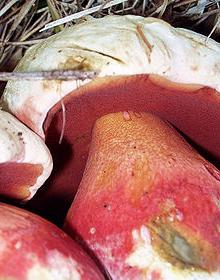 Yellowish shades with a hint of olive color can be widespread in dark places where light levels are very low. Usually it is under old oak and linden groves with dense growth of young growth. The leg of this mushroom is similar to the leg of a mushroom, however, if you make an incision, you can observe how blue appears at first, and then bright red. This is the interaction of oxygen from the surrounding air with the poison.
Yellowish shades with a hint of olive color can be widespread in dark places where light levels are very low. Usually it is under old oak and linden groves with dense growth of young growth. The leg of this mushroom is similar to the leg of a mushroom, however, if you make an incision, you can observe how blue appears at first, and then bright red. This is the interaction of oxygen from the surrounding air with the poison.
How to distinguish
You can distinguish it by an unpleasant smell, reminiscent of often rotten onions. Although at a young age such a vivid sign may be completely absent. So be careful about the incision of the legs. If it turns blue in a few minutes, it is urgent to get rid of this fungus. At home, you are unlikely to be able to determine this.
He is generally edible
They say that if the satanic mushroom passes the right heat treatment, it will be quite edible, however, we strongly advise you not to test your health.






